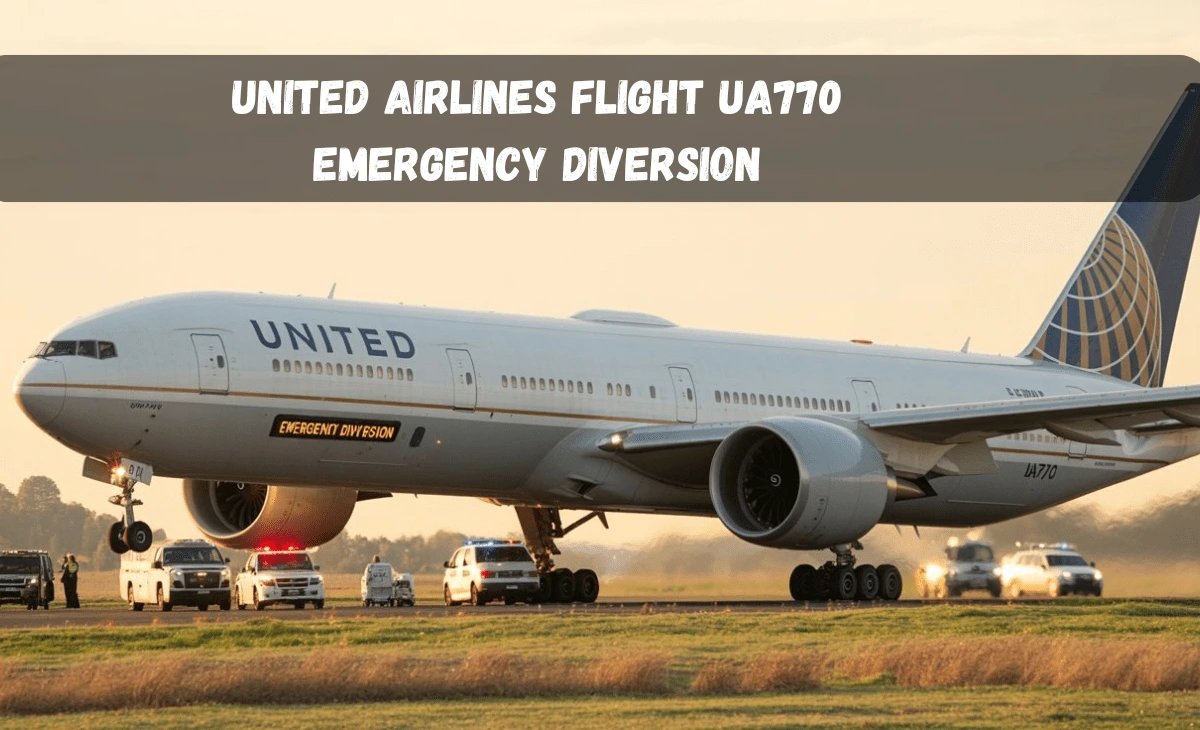United Airlines Flight ua770 emergency diversion, which was scheduled to fly from Los Angeles International Airport (LAX) to Washington Dulles International Airport (IAD), recently experienced an emergency diversion that brought it into the spotlight. The crew detected a technical issue while cruising, leading to the flight’s mid-air diversion. Such incidents, though rare, are taken very seriously in the aviation world because they involve critical decision-making under pressure, prioritizing the safety of all onboard.
This article offers clear, detailed information for passengers who are searching for answers about this incident or want to understand what an emergency diversion means and how airlines handle it. Whether you’re a frequent flyer or simply following the news, this breakdown will help you understand the facts and the safety processes involved.
What led to the emergency diversion?
Flight UA770 took off normally from LAX, with no reported delays or irregularities at the time of departure. However, not long after reaching cruising altitude, the flight crew observed abnormal readings related to cabin pressure. Cabin pressure systems are vital for keeping conditions safe and breathable at high altitudes. Any variation or technical alert related to this system can trigger an emergency response. In this case, the pilots followed protocol and decided to divert the aircraft to the nearest suitable airport Denver International Airport for inspection and passenger safety.
The aircraft landed without incident. Emergency response teams were on standby as a precautionary measure, but no injuries or serious issues were reported. The passengers were safely deboarded and provided with alternate travel arrangements.
Why do flight diversions happen?
Flight diversions are unplanned changes to the aircraft’s original destination due to unforeseen circumstances. We take these events seriously and only proceed when reaching the original destination could present a risk or challenge.
Common reasons for emergency diversions include:
- Mechanical or technical issues, such as faulty sensors or system alerts
- Medical emergencies involving passengers or crew
- Severe weather or turbulence that makes the original route unsafe
- Fuel imbalance or shortages
- Security threats or disruptive passenger behavior
How airlines respond to in-flight emergencies
The safety of passengers and crew is always the highest priority for any airline. In the case of United Airlines flight ua770 emergency diversion, United Airlines followed a well-established emergency procedure designed to respond to mid-air incidents quickly and effectively.
Upon detecting an issue, the pilot evaluates its severity using the cockpit instruments and the ground-based flight operations center. Immediately upon declaring an emergency, the pilot contacts air traffic control to arrange a new flight path and clear a runway at the diversion airport. Emergency teams, including fire and medical personnel, are often alerted to stand by. Once the aircraft lands, technical crews inspect it, and passengers are either transferred to another aircraft or rebooked on later flights.
What passengers experienced on UA770
While technical diversions may sound dramatic, passengers on UA770 reported a relatively calm experience. The crew informed them of the situation promptly, and the descent into Denver was smooth. The incident speaks to the professionalism of the airline staff and the effectiveness of safety training.
United Airlines offered assistance in rebooking, and most passengers resumed their travel plans within hours. For many, it was a reminder of the complex systems in place to keep air travel safe, even when things don’t go exactly as planned.
Benefits of strict diversion protocols
Emergency diversion procedures might cause delays or inconvenience, but they exist for good reason. Here’s why they’re essential:
- Ensure immediate responses to potentially dangerous issues.
- Allow aircraft to be checked before problems escalate
- Provide medical help quickly if needed
- Maintain passenger confidence in airline safety
- Reflect the airline’s commitment to protecting lives
Challenges involved in diversions
While these protocols are critical, they also introduce several challenges for airlines, crews, and passengers alike. For airlines, diversions can lead to significant costs extra fuel, landing fees at alternate airports, and rebooking logistics. Crews must stay calm and comply with strict aviation rules even under pressure. Passengers may face extended delays, missed connections, or stress, particularly if they are unfamiliar with what a diversion means.
Despite these challenges, the handling of United Airlines flight ua770 emergency diversion demonstrates the significant impact of effective communication, pilot training, and emergency preparedness.
Here is what to do if your flight is diverted:
Knowing how to respond can alleviate the stress of a diverted flight. Here are some useful steps:
- Stay calm and listen carefully to announcements from the crew.
- Avoid speculating or spreading unverified information.
- Contact the airline through its mobile app or website to get rebooking details.
- Keep essentials like ID, phone charger, medications, and travel documents in your carry-on.
- Follow instructions from ground staff upon arrival
Are passengers compensated for diversions?
In most cases, emergency diversions caused by technical issues or weather are not eligible for financial compensation under U.S. law. However, airlines often provide support such as meal vouchers, hotel stays, and rebooking assistance. In regions governed by different laws, such as the EU, compensation may apply depending on the cause and delay duration.
United Airlines has not issued a compensation statement for UA770 specifically, but passengers were reportedly taken care of in accordance with the company’s customer service policies.
What this incident tells us about aviation safety
The emergency diversion of United airlines flight ua770 emergency diversion is a strong example of the airline industry’s commitment to safety. Though diversions are rare, they are rehearsed, monitored, and carefully executed when needed. The crew’s rapid response, the safe landing, and the organized handling of passengers all demonstrate how much preparation goes into dealing with these situations.
It’s important to understand that an emergency diversion is not a failure it is a precaution. In this case, it shows that the systems worked as intended. The safety alert initiated the appropriate response, safeguarding both the passengers and the aircraft from potential harm.
Frequently asked questions
What happened to United Airlines Flight UA770?
The flight was diverted to Denver due to a suspected issue with cabin pressure systems. The diversion was handled safely, and no injuries were reported.
Was the diversion caused by a serious malfunction?
The issue is believed to have been related to a cabin pressure warning, possibly caused by a faulty sensor. The diversion was precautionary.
Did passengers face delays after the diversion?
Some passengers were rebooked on later flights, and United Airlines provided assistance. Most continued their journeys within a short period.
Do passengers get compensation for diversions?
Not always. If the diversion is for safety reasons, compensation is limited. However, passengers are usually offered support and rebooking help.
How common are flight diversions?
They are relatively rare. When they do occur, it is often due to medical issues or technical concerns, and airlines are trained to handle them smoothly.
For more Travel blogs visit : waconiacomed.com/category/travel/
Conclusion with a clear takeaway
The emergency diversion of United Airlines flight ua770 emergency diversion may have caused temporary disruptions, but it ultimately proved how serious the aviation industry is about safety. Every step of the response, from detecting the issue to the safe landing in Denver, adhered to tested and proven procedures.
For passengers, the experience may have been unexpected, but it should also be reassuring. Flying remains one of the safest forms of travel, and incidents like this reinforce that safety always comes first.
If you want to stay informed about air travel safety and updates like UA770, consider subscribing to reliable aviation news sources or following your preferred airline’s safety updates online.

